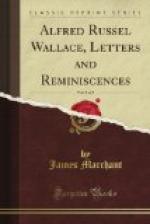a chapter to the New Zealand flora in order to see
how far the geological and physical relations between
New Zealand and Australia would throw light on its
origin, I went for my facts to the works of Sir Joseph
Hooker and Mr. Bentham, and also to your article in
the “Encyclopaedia Britannica,” and worked
out my conclusions solely from these, and from the
few facts referring to the migration of plants which
I had collected. Had I referred again to your
lecture I should certainly have quoted the cases you
give (in a note, p. 431) of plants extending along
the Andes from California to Peru and Chile, and vice
versa. Whatever identity there is in our views
was therefore arrived at independently, and it was
an oversight on my part not referring to your views,
partly due to your not having made them a more prominent
feature of your very interesting and instructive lecture.
Working as I do at home, I am obliged to get my facts
from the few books I can get together; and I only
attempted to deal with these great botanical questions
because the facts seemed sufficiently broad and definite
not to be much affected by errors of detail or recent
additions to our knowledge, and because the view which
I took of the past changes in Australia and New Zealand
seemed calculated to throw so much light upon them.
Without such splendid summaries of the relations of
the Southern floras as are given in Sir J. Hooker’s
Introductions, I should not have touched the subject
at all; and I venture to hope that you or some of
your colleagues will give us other such summaries,
brought down to the present date, of other important
floras—as, for example, those of South
Africa and South Temperate America.
Many thanks for additional peculiar British plants.
When I hear what Mr. Mitten has to say about the mosses,
etc., I should like to send a corrected list
to Nature, which I shall ask you to be so good
as to give a final look over.—Believe me
yours very faithfully,
ALFRED R. WALLACE.
P.S.—Mr. Darwin strongly objects to my
view of the migration of plants along mountain-ranges,
rather than along lowlands during cold periods.
This latter view seems to me as difficult and inadequate
as mine does to him.—A.R.W.
* * * *
*
Wallace was in frequent correspondence with Professor
Raphael Meldola, the eminent chemist, a friend both
of Darwin and of Wallace, a student of Evolution,
and a stout defender of Darwinism. I received
from him much help and advice in connection with this
work, and had he lived until its completion—he
died, suddenly, in 1914—my indebtedness
to him would have been even greater.
The following letter to Meldola refers to a suggestion
that the white colour of the undersides of animals
might have been developed by selection through the
physical advantage gained from the protection
of the vital parts by a lighter colour and
therefore by a surface of less radiative activity.
The idea was that there would be less loss of animal
heat through such a white coating. We were at
that time unaware of Thayer’s demonstration
of the value of such colouring for the purposes of
concealment among environment. Wallace accepted
Thayer’s view at once when it was subsequently
put forward; as do most naturalists at the present
time.




